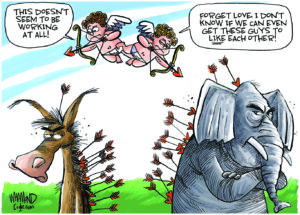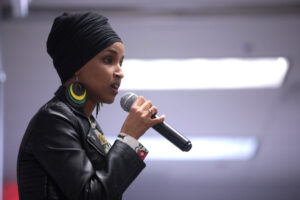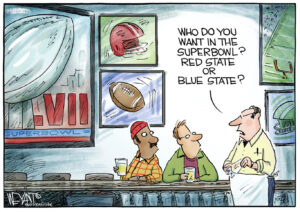The Unpleasant, Undeniable Political Realities of Our Moment
Polarization is not just an elite thing. It reflects deeply held opinions among voters themselves. A protest against Donald Trump in Minneapolis on Jan. 20, 2018, the anniversary of his inauguration. (Fibonacci Blue / CC BY 2.0)
A protest against Donald Trump in Minneapolis on Jan. 20, 2018, the anniversary of his inauguration. (Fibonacci Blue / CC BY 2.0)
We human beings cling to dogmas long after they’re disproven. We tend to believe things that make us feel better or remind of us of a past that we miss. This is certainly true of our assumptions about electoral politics.
Among the myths that can steer us off course in the Trump era, three are particularly popular.
First, that political polarization is primarily a product of how elites behave and not the result of real divisions in our country.
Second, that a vast group of party-loathing independents can be mobilized by anti-partisan messages.
Third, that Republicans and Democrats are becoming increasingly and equally extreme, so they should be scolded equally.
All these pious wishes are false, as Alan Abramowitz’s latest book, “The Great Alignment: Race, Party Transformation, and the Rise of Donald Trump,” makes clear. He provides a wealth of data in a compact package.
A political scientist at Emory University, Abramowitz is perhaps best known for the idea of “negative partisanship.” It explains a great deal about the fractious nature of our public sphere.
“Over the past two decades,” he writes, “the proportion of party supporters … who have strongly negative feelings toward the opposing party has risen sharply. A growing number of Americans have been voting against the opposing party rather than for their own.”
People rate their own side about the same as they used to. On a 100-degree “feeling thermometer,” Americans gave their own party a moderately warm 71 degrees in 1978, and 70 degrees in 2012.
But over the same years, their sentiments toward the opposing party turned ice cold, plummeting from 47 degrees to 30 degrees. When politicians are nasty to the other side, they are mirroring the attitudes of their supporters. Polarization, in other words, is not just an elite thing. It reflects deeply held opinions among voters themselves.
Democrats draw “their strongest support from groups with the most positive views of recent social and cultural changes.” Conversely, the GOP is strongest with groups having “the most negative views” of those changes.
In another important new book, “Standoff: How America Became Ungovernable,” the veteran political analyst Bill Schneider notes that while polarization did not begin with President Trump (it “has been going on for at least 50 years”), Trump “uses every issue, every policy, every tweet to set one group of Americans against another.” Divisions around issues related to immigration, race and culture serve the president’s interests.
Ah, but since increasing numbers of Americans identify as independents, isn’t there an eager nonpartisan middle waiting to rescue us from all this?
Sorry, but no. As Abramowitz shows, most people who identify as independents lean toward one party or the other. When it comes to casting ballots, “leaning independents as well as strong and weak party identifiers are voting more along party lines than at any time in the past half century.”
Factoring out independents who tilt toward a party, “only about 12 percent of Americans have fallen into the ‘pure independent’ category, and these people are much less interested in politics and much less likely to vote than independent leaners.” Independents are plainly not some magical force that will call into being that centrist third party that looms so large in the imaginations of many pundits and fundraisers.
And the centrist heavenly chorus is off-key in another respect: While it sings mournful songs about the major parties becoming “extreme,” Abramowitz’s data makes clear that the two sides are not equivalent. Republicans have moved significantly further to the right than Democrats have moved to the left.
Between 1972 and 2012, he notes, the proportion of Democrats who put themselves at the center of the ideological spectrum (or were unable to place themselves) fell from 52 percent to 41 percent, an 11-point drop. In the same period, the comparable figures for Republicans were 44 percent and 22 percent, double the Democratic swing.
The upshot: The share of Democrats in the ideological middle is nearly twice that of Republicans.
Abramowitz doesn’t polemicize; he simply lays out the facts. But the story he tells suggests the essential first step to getting past extremism and polarization is the defeat of today’s intemperate brand of Republicanism, embodied by the most intemperate president in our history.
Those who long for moderate and harmonious politics find it both comforting and convenient to cling to myths that allow them to keep their distance from charges of grubby “partisanship.” They’re likelier to get what they want by accepting the unpleasant but also undeniable realities of our moment.
Your support matters…Independent journalism is under threat and overshadowed by heavily funded mainstream media.
You can help level the playing field. Become a member.
Your tax-deductible contribution keeps us digging beneath the headlines to give you thought-provoking, investigative reporting and analysis that unearths what's really happening- without compromise.
Give today to support our courageous, independent journalists.






You need to be a supporter to comment.
There are currently no responses to this article.
Be the first to respond.